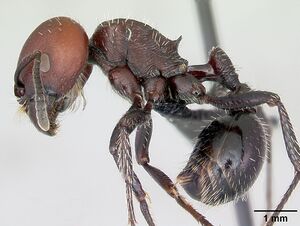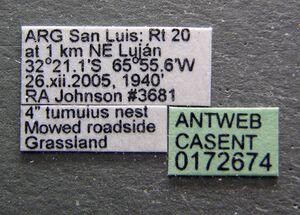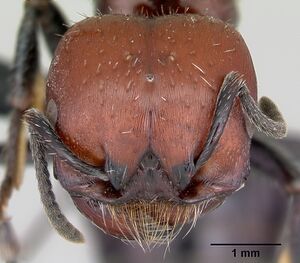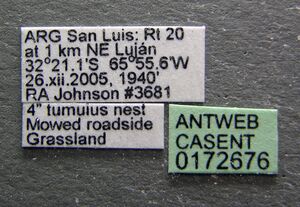Pogonomyrmex micans
| Pogonomyrmex micans | |
|---|---|

| |
| Scientific classification | |
| Kingdom: | Animalia |
| Phylum: | Arthropoda |
| Class: | Insecta |
| Order: | Hymenoptera |
| Family: | Formicidae |
| Subfamily: | Myrmicinae |
| Tribe: | Pogonomyrmecini |
| Genus: | Pogonomyrmex |
| Species group: | coarctatus |
| Species: | P. micans |
| Binomial name | |
| Pogonomyrmex micans Forel, 1914 | |
A lowland species that collects a range of grass and non-grass seeds.
Identification
Johnson (2015) - Worker Within the P. coarctatus-group, the combination of: (1) fine, dense, longitudinal striae cover cephalic dorsum, (2) coarse rugae on posterior surface of petiolar node, rugae less coarse and more dense on dorsum of postpetiole, (3) in profile, lateral lobe of clypeus poorly-developed with broad gap between clypeal lobe and frontal lobe (gap as wide as to wider than antennal scape), and (4) bicolored—head reddish-brown; mesosoma, petiolar node, postpetiole reddish-brown to blackish-red; gaster reddish-black to nearly black uniquely characterize this species.
Queen This caste is diagnosed by: (1) caste-specific morphology of the mesosoma related to wing-bearing and presence of ocelli on head, (2) large size (HW = 2.94–3.09 mm), (3) striae cover cephalic dorsum, (4) in profile, lateral lobe of clypeus not enlarged with broad gap (similar to the width of antennal scape) between clypeal lobe and frontal lobe, and (5) bicolored—head reddish-orange; gaster reddish-brown to nearly black.
Male This caste is diagnosed by: (1) first gastral tergum lacking striae, (2) large (HW > 1.80 mm; HL > 1.65 mm; ML > 2.75 mm), (3) hairs on head (especially posterior to eyes) and dorsum of mesosoma dense, long and flexuous, length of numerous hairs approach to exceed MOD, (4) mandibles with four teeth, and (5) interrugae on katepisternum dull.
Pogonomyrmex micans co-occurs with Pogonomyrmex coarctatus, and it likely co-occurs with Pogonomyrmex lobatus. Pogonomyrmex micans is distinguished from P. coarctatus using the following characters: (1) in P. micans, fine, dense, longitudinal striae cover the cephalic dorsum, (2) dorsum of postpetiole has prominent moderately coarse rugae, and (3) workers are bicolored (dark red and blackish). In P. coarctatus: (1) the very fine, dense, longitudinal striae are often indistinct and cover only part to most of head, (2) dorsum of postpetiole is weakly to moderately granulate-punctate, occasionally with weak rugae near posterior margin, and (3) the body is mostly concolorous reddish-orange to reddish-brown. Pogonomyrmex micans is distinguished from P. lobatus by the following characters: (1) the lateral lobe of clypeus not enlarged, (2) the dorsum of the postpetiole has prominent moderately coarse rugae, and (3) workers are bicolored (dark red and blackish). In P. lobatus: (1) the lateral lobe of clypeus is massively enlarged, nearly contacting the frontal lobe, (2) dorsum of postpetiole weakly to moderately granulate, rarely with weak transverse rugae posteriorly, and (3) workers are concolorous reddish-orange to reddish-brown. Pogonomyrmex marcusi is only known from mid- to higher elevations in central Bolivia and thus is geographically isolated from P. micans; these two species can be separated using characters in the key.
Keys including this Species
- Key to Pogonomyrmex queens of South American
- Key to Pogonomyrmex workers of South American
- Key to South American Pogonomyrmex
- Pogonomyrmex de Sur America clave a las obreras
- Pogonomyrmex de Sur America clave a las reinas
Distribution
Latitudinal Distribution Pattern
Latitudinal Range: 31.422912° to -33.43388889°.
| North Temperate |
North Subtropical |
Tropical | South Subtropical |
South Temperate |
- Source: AntMaps
Distribution based on Regional Taxon Lists
Neotropical Region: Argentina (type locality), Paraguay.
Distribution based on AntMaps
Distribution based on AntWeb specimens
Check data from AntWeb
Countries Occupied
| Number of countries occupied by this species based on AntWiki Regional Taxon Lists. In general, fewer countries occupied indicates a narrower range, while more countries indicates a more widespread species. |

|
Estimated Abundance
| Relative abundance based on number of AntMaps records per species (this species within the purple bar). Fewer records (to the left) indicates a less abundant/encountered species while more records (to the right) indicates more abundant/encountered species. |

|
Habitat
Pogonomyrmex micans is a lowland species that inhabits elevations from 145–910 m. This species is most common in the Dry Chaco, but it also ranges into the Humid Chaco and the eastern edge of the Low Monte Desert ecoregion as defined by Olson et al. (2001). A record from Jujuy appears to be an outlier at the edge of the Central Andean Puna/Southern Andean Yungas ecoregions; these specimen were probably collected in a valley at lower elevations. (Johnson 2015)
Biology
Johnson (2015) - Pogonomyrmex micans is a solitary forager that harvests the seeds of various grass and nongrass species, but very loose columns of scattered foragers also have been observed. Nests are variable, ranging from entrances lacking a tumulus to ones with a tumulus up to 15 cm in diameter. Colonies of P. micans are probably similar in size to those of P. coarctatus suggesting that they contain up to about 2000 workers.
Collection dates for sexuals range from 26 December to 22 January, suggesting that mating flights occur during the austral summer (January–February). Queens of P. micans contained an average of 12.5 ovarioles (n = 2); queen dry mass averaged ( ± SE) 20.7 ± 0.4 mg (n = 5) (R.A. Johnson, unpub. data).
Castes
Worker
Images from AntWeb
   
| |
| Worker. Specimen code casent0172674. Photographer April Nobile, uploaded by California Academy of Sciences. | Owned by RAJC, Robert A. Johnson Collection. |
Queen
Images from AntWeb
    
| |
| Queen (alate/dealate). Specimen code casent0172675. Photographer April Nobile, uploaded by California Academy of Sciences. | Owned by RAJC, Robert A. Johnson Collection. |
Male
Images from AntWeb
     
| |
| Male (alate). Specimen code casent0172676. Photographer April Nobile, uploaded by California Academy of Sciences. | Owned by RAJC, Robert A. Johnson Collection. |
Nomenclature
The following information is derived from Barry Bolton's Online Catalogue of the Ants of the World.
- micans. Pogonomyrmex bruchi r. micans Forel, 1914d: 268 (w.m.) ARGENTINA. Raised to species: Kusnezov, 1951a: 254.
Unless otherwise noted the text for the remainder of this section is reported from the publication that includes the original description.
Description
Johnson (2015):
Worker
Lectotype (n = 20). HL 2.09 (2.02–2.64); HW 2.25 (2.10–2.80); MOD 0.45 (0.42–0.56); OMD 0.41 (0.40–0.60); SL 1.48 (1.23–1.73); PNW 1.48 (1.31–1.79); HFL 1.67 (1.81–2.32); ML 2.10 (2.17–2.80); PW 0.51 (0.49–0.70); PPW 0.70 (0.63–0.91). Indices: SI 65.78 (52.50–63.84); CI 107.66 (102.65–112.44); OI 20.00 (15.88–22.03); HFI 74.22 (68.95–89.05).
Monomorphic, head slightly wider to wider than long (CI = 102.65–112.44), posterior margin flat to weakly concave in full-face view. Fine, dense, longitudinal striae cover cephalic dorsum, width of striae and interstriae similar; medial striae not diverging toward posterior corners of head. Cephalic interstriae dull to weakly shining; vertex smooth and shining or with very fine, dense striae; interstriae smooth, weakly shining to shining; entire cephalic dorsum with silky appearance. Anterior margin of clypeus concave; dorsal surface with numerous moderately coarse subparallel, longitudinal to oblique rugae. Numerous long, curved, bristle-like, yellowish macrochaetae project from anterior margin of clypeus and ventral surface of mandibles. Mandible with six teeth, rarely with an additional denticle between 4th and 5th teeth; mandibular dorsum coarsely rugose. MOD ranging from 0.17–0.23x HL. In profile, eyes situated anterior to middle of head, OMD = 0.88–1.13x MOD. Antennal scapes short (SI = 52.50–63.84), extending less than one-third the distance from posterior margin of eye to posterior corner of head. Base of antennal scapes smooth and shining, distal portion weakly striated, weakly to strongly shining; basal flange well-developed with carinate margin. Psammophore well-developed.
Mesosomal profile weakly to moderately convex; all mesosomal surfaces with prominent coarse, subparallel, weakly irregular, widely-spaced rugae. In dorsal view, humeral shoulders of pronotum rounded to knoblike. Dorsum of promesonotum with longitudinal rugae that diverge anteriorly toward humeral shoulders of pronotum; transverse rugae on anterior surface of pronotum continue obliquely or longitudinally on pronotal sides; rugae on mesopleura angle posterodorsally. Superior propodeal spines long, acuminate, connected by well-defined keel; spine length about equal to width between their bases; regular to weakly wavy, transverse rugae on propodeal dorsum traverse ventrally or anteroventrally on sides. Inferior propodeal spines wider than long, apex rounded to angulate. Propodeal spiracles narrowly ovate facing posterad. Interrugae on mesosoma weakly to moderately granulate, weakly shining to shining. Legs weakly granulate, weakly shining.
Peduncle of petiole about 0.8x as long as petiolar node, anteroventral margin with broadly rounded process. In profile, posterior surface of petiolar node weakly convex; node asymmetrical with anterior surface notably shorter than posterior surface, apex rounded. In dorsal view, petiolar node longer than wide, widest near middle, narrowing to spatulate to weakly acute anterior margin. Sides and posterior surface of petiolar node with coarse, wavy to irregular, transverse rugae. Dorsum of postpetiole convex in profile; in dorsal view, widest near posterior margin, narrowing to anterior margin, maximum width about equal to length. Regular to wavy, fine, dense, transverse rugae on dorsum of postpetiole, sometimes lacking on anterior margin; interrugae on posterior surface of petiolar node and dorsum of postpetiole weakly to moderately granulate, dull to weakly shining. First gastral tergum moderately coriarious, weakly shining to smooth and shining.
Erect white to yellowish pilosity moderately abundant on head, variable in length and arising from foveae; longest hairs not exceeding MOD, few >0.5x MOD. Moderately abundant suberect pilosity on scape; abundant decumbent hairs on funicular segments. Legs with moderately abundant suberect to decumbent setae. Mesosoma, petiolar node, postpetiole, first gastral tergum with moderately dense erect setae that are similar in length, longest hairs shorter than MOD; length of hairs on margins of posterior gastral terga occasionally >MOD. Head reddish-brown; mesosoma, petiolar node, postpetiole reddish-brown to blackish-red; antennae, legs, gaster reddish-brown to nearly black.
Queen
(n = 7). HL 2.50–2.84; HW 2.94–3.09; MOD 0.55–0.64; OMD 0.59–0.64; SL 1.52–1.68; PNW 2.01–2.23; HFL 2.20–2.47; ML 3.46–3.62; PW 0.77–0.91; PPW 1.04–1.19. Indices: SI 49.19–55.08; CI 108.10–122.13; OI 18.71–20.85; HFI 71.66–80.98.
Large species (HW = 3.94–3.09 mm) with caste-specific morphology of the mesosoma related to wing-bearing and presence of ocelli on head. In full-face view, head wider than long (CI = 108.1–122.1), posterior margin weakly concave medially. Fine, dense, longitudinal striae cover cephalic dorsum; striae on vertex often less abundant or absent. Interstriae weakly shining to shining. Mandible with six teeth, dorsal surface coarsely rugose. Psammophore well-developed.
All mesosomal surfaces with subparallel, weakly irregular rugae. Superior propodeal spines short. Peduncle of petiole slightly shorter than petiolar node, anteroventral margin with blunt to angulate process. In profile, petiolar node asymmetrical with anterior surface notably shorter than posterior surface, apex rounded. Postpetiole slightly wider than long. Posterior surface of petiolar node and dorsum of postpetiole with wavy to irregular transverse rugae, rugae coarser on petiolar node than postpetiole; interrugae weakly punctate, weakly shining. Gastral terga smooth, weakly shining to shining. Most body surfaces with moderately abundant suberect to erect, short white to yellowish setae. Head reddish-orange; mesosoma, petiolar node, postpetiole reddish-brown to blackish-red; gaster reddish-brown to nearly black.
Male
(n = 12). HL 1.67–1.95; HW 1.82–2.11; MOD 0.59–0.68; OMD 0.20–0.38; SL 0.44–0.56; PNW 1.64–1.99; HFL 1.81–2.20; ML 2.99–3.49; PW 0.68–0.83; PPW 0.82–1.02. Indices: SI 22.34–29.26; CI 100.00–126.35; OI 30.41–35.29; HFI 95.90–115.51.
Type Material
- Lectotype (designated by Johnson, 2015: 37), worker, San Luis: Alto Pencoso near La Plata, Argentina, Bruch, #224, CASENT0217254, Museo de La Plata, Argentina.
- Paralectotype (designated by Johnson, 2015: 37), 1 worker, San Luis: Alto Pencoso near La Plata, Argentina, Bruch, #224, Museo de La Plata, Argentina.
- Paralectotype (designated by Johnson, 2015: 37), 26 workers, 2 males, San Luis: Alto Pencoso near La Plata, Argentina, Bruch, #224, Musee d'Histoire Naturelle Genève.
Etymology
The specific epithet, micans (from Latin, micans = shining, gleaming, or sparkling), apparently refers to the head, which Forel described as subopaque with a silky aspect.
References
- Cantone S. 2018. Winged Ants, The queen. Dichotomous key to genera of winged female ants in the World. The Wings of Ants: morphological and systematic relationships (self-published).
- Forel, A. 1914d. Formicides d'Afrique et d'Amérique nouveaux ou peu connus. Bull. Soc. Vaudoise Sci. Nat. 50: 211-288 (page 268, worker, male described)
- Johnson, R.A. 2015. A taxonomic revision of South American species of the seed-harvester ant genus Pogonomyrmex (Hymenoptera: Formicidae). Part I. Zootaxa 4029:1–142 (doi:10.11646/zootaxa.4029.1.1).
- Johnson, R.A. 2021. A taxonomic revision of South American species of the seed-harvester ant genus Pogonomyrmex (Hymenoptera: Formicidae). Part II. Zootaxa 5033, 1–230 (doi:10.11646/zootaxa.5033.1.1).
- Kusnezov, N. 1951e. El género Pogonomyrmex Mayr (Hym., Formicidae). Acta Zool. Lilloana 11: 227-333 (page 254, Raised to species)
References based on Global Ant Biodiversity Informatics
- Johnson R. A. 2015. A taxonomic revision of South American species of the seed-harvester ant genus Pogonomyrmex (Hymenoptera: Formicidae). Part I. Zootaxa 4029(1):1-142
- Johnson Robert. 2014. List of South American species of Pogonomyrmex. Accessed on February 5th 2014 at http://www.asu.edu/clas/sirgtools/pogonomyrmex/SOUTHAMERICANPOGOS.htm
- Wild, A. L. "A catalogue of the ants of Paraguay (Hymenoptera: Formicidae)." Zootaxa 1622 (2007): 1-55.

